
Pennsylvania’s Big Program to Save Rural Hospitals Gets Mixed Financial Reviews
Stable Payments Improved Margins But Not Liquidity, New LDI Analysis Finds
Brief
Medicaid has long been a political litmus test and a target for substantial programmatic changes. But what does the public feel about Medicaid, especially during a pandemic? In this study, the authors analyze more than one million Medicaid-related tweets from December 1, 2018 to September 30, 2020. They found a high volume of political posts on Twitter around Medicaid topics, peaking in January 2020 in the context of news about Medicaid expansion and the prior administration’s Medicaid block grant proposal. As the pandemic hit, the number of Twitter posts about Medicaid and the pandemic increased, and the volume of political tweets on other Medicaid topics dropped. The posts themselves also appeared to be less polarized. These patterns suggest that when the public sees Medicaid operate as a safety net, the program is far less polarizing than partisan politics might indicate. Highlighting Medicaid’s role during the pandemic could help strengthen public support for the program in non-crisis times and better position it to respond to future economic downturns.
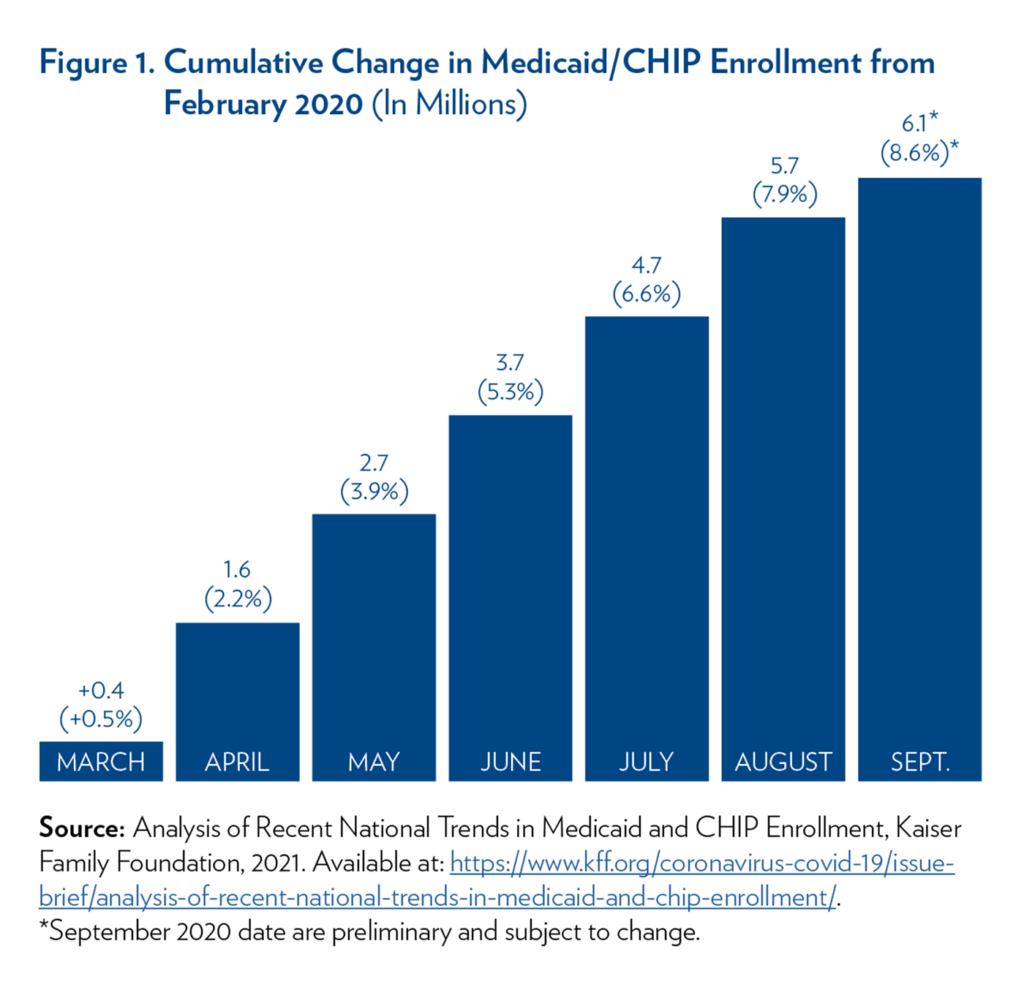
The Medicaid program, which provides coverage to about one in five Americans, has long been a political litmus test. Depending on the administration, as well as the underlying economy, the program has been targeted for substantial expansion, contraction, or transformation.
The program is countercyclical, in that enrollment (and government spending) increases during economic downturns. Medicaid acts as a social safety net for people when the economy worsens, and when rising unemployment puts many people into poverty. This aspect of Medicaid was on full display during the early phase of the COVID-19 pandemic: from February through September 2020, more than 6 million people were added to the Medicaid rolls (see Figure 1), reversing two years of enrollment declines.
Policy around Medicaid also tends be countercyclical, in that policymakers often focus on shrinking the Medicaid rolls in times of economic growth, and bolster funding in economic hard times. Prior to the pandemic, the Trump administration signaled its willingness to approve work requirements in Medicaid to reduce dependency on government programs. Twelve states received approval, although none of the requirements is currently in effect. After the pandemic emerged, policymakers sought to respond to the growing need by temporarily enhancing the federal Medicaid matching funds in the Families First Coronavirus Response Act (FFCRA). States could receive additional federal funds if they ensured continuous coverage for existing enrollees and maintained current eligibility criteria. During the pandemic, states have seen their Medicaid rolls grow anywhere from 4% to 18%.1
It is not clear whether public sentiment about Medicaid shifts along with these political and economic cycles. Polling shows strong support for Medicaid among the general public; in the July 2019 KFF Health Tracking Poll,2 three-fourths reported a favorable view of the program, while just one-fifth reported an unfavorable view. Most Democrats (85%), independents (76%), and Republicans (65%) viewed the program favorably. In a 2019 study, more than two-thirds of adults in states that had not yet expanded Medicaid under the Affordable Care Act (ACA) favored expanding eligibility for the program.3 This could explain successful ballot initiatives to expand Medicaid in six states: Maine in 2017, Idaho, Nebraska, and Utah in 2018, and Oklahoma and Missouri in 2020. Public sentiment is more divided and partisan when it comes to Medicaid work requirements: a recent survey found that public opinion is split relatively evenly about work requirements, with support higher among conservatives, those who see Medicaid as a short-term program, as well as among non-Hispanic whites who have high levels of racial resentment.4
These snapshots do not tell us how public sentiment changes in response to current events. From a practical standpoint, the program is continually undergoing policy and programmatic changes on a federal and state level. These broad changes make it increasingly important for policymakers and Medicaid stakeholders to understand how the public views the Medicaid program in the context of current events.
Social media provides opportunities for researchers and policymakers to better understand public sentiment, including changes over time. Twitter is an interactive social media platform used by about 20% of online adults,5 allowing users to send 280-character messages to one another. The platform sees over 500 million tweets per day on topics including health-related experiences, behaviors, and concerns. While the “Twitterverse” is not representative of the general public, the demographics of Twitter use –significantly higher in young adults compared with older age groups – maps well to Medicaid populations, 93% of whom are younger than age 65 and 80% of whom are under the age of 45.6
To assess changes in public sentiment about Medicaid, we conducted an exploratory analysis of more than one million Medicaid-related tweets from December 1, 2018 to September 30, 2020, allowing us to capture patterns before and during the pandemic.
We collected data using Twitter’s streaming interface, applying key search terms including medicaid, its common misspellings (e.g., medicade and medicaide), as well as branded Medicaid agency and managed care organization names (e.g., Medi-cal, California’s Medicaid program). Using a grounded theory approach, we categorized tweets into five broad categories:
We developed a coding scheme by manually coding 800 tweets. Three coders independently coded the same tweets, and resolved disagreements and updated the coding guidelines via discussion. Two coders then reviewed a new set of 5,338 tweets, yielding substantial inter-coder agreement over 998 overlapping tweets.
We then coded tweets iteratively to develop supervised machine learning models. In total, 11,379 tweets were coded. The best performing model was then applied to a corpus consisting of 1,812,308 tweets, collected from December 2018 through September 2020, most of which were political opinion/advocacy (69%). This corpus was restricted to tweets that mentioned medicaid or its common misspellings explicitly. Duplicate posts and retweets were also removed.
Because of the predominance of political opinion tweets, and Medicaid’s longstanding status as a political lightning rod, we focused our analysis on these tweets. We applied natural language processing to remove tweets with very similar content and calculated term frequencies for unigrams, bigrams, and trigrams—contiguous sequences of 1, 2, and 3 words —and identified the most frequent terms in each category. We also performed an analysis based on the frequency of terms or phrases for all tweets in one category, allowing us to distinguish content that is unique to that specific category, rather than those common to all tweets in the dataset. Finally, we analyzed specific high-volume topics, including work requirements, Medicaid expansion, mental health, and the pandemic. We used polarity scores to classify tweets as negative, neutral, or positive. The remainder of the brief focuses on results among the set of tweets labeled as “political opinion.”
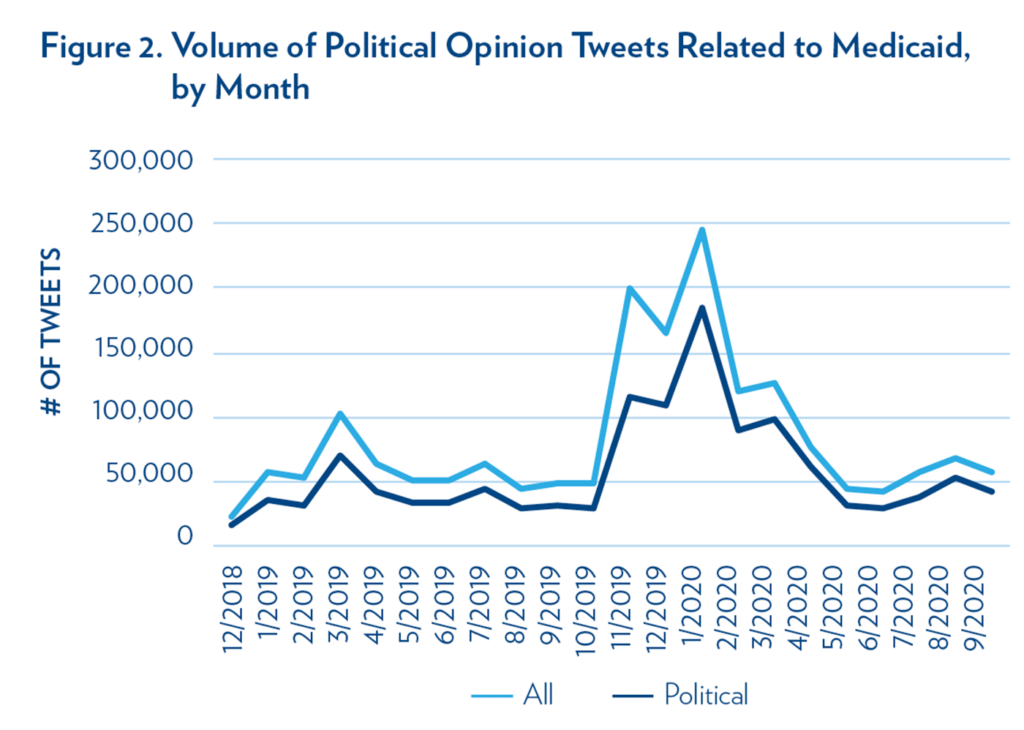
The volume of political opinion tweets about Medicaid fluctuated from a nadir of approximately 15,000 tweets in December 2018 to nearly 185,000 tweets in January 2020, echoing the volume of tweets about Medicaid more generally (Figure 2). The high volume of Twitter chatter in January 2020 appears to be focused on a flurry of Medicaid-related news reports about the Trump administration’s block grant proposal7 as well as Medicaid expansion efforts in specific states.
Table 1 shows a selection of political opinions related to specific topics pertaining to the Medicaid program, some of which advocate for specific political or policy stances, or which tag political figures or institutions.
In Figure 3, we look at temporal trends in the frequency of specific Medicaid-related topics. For example, there are slight spikes in discussions around work requirements and block grants in early 2019, as well as early 2020, likely corresponding to news about Medicaid work requirements (for example, Arkansas and Kentucky work requirements were struck down in federal court in March 2019 and upheld in court of appeals in February 2020). In comparison, a topic that is less dependent on news cycles — like mental health, for which Medicaid is a large payer of services — had a lower volume of chatter and less month-to-month fluctuation. In February 2020, as the COVID-19 pandemic spread in the U.S., tweets about coronavirus within the Medicaid context increased in volume.
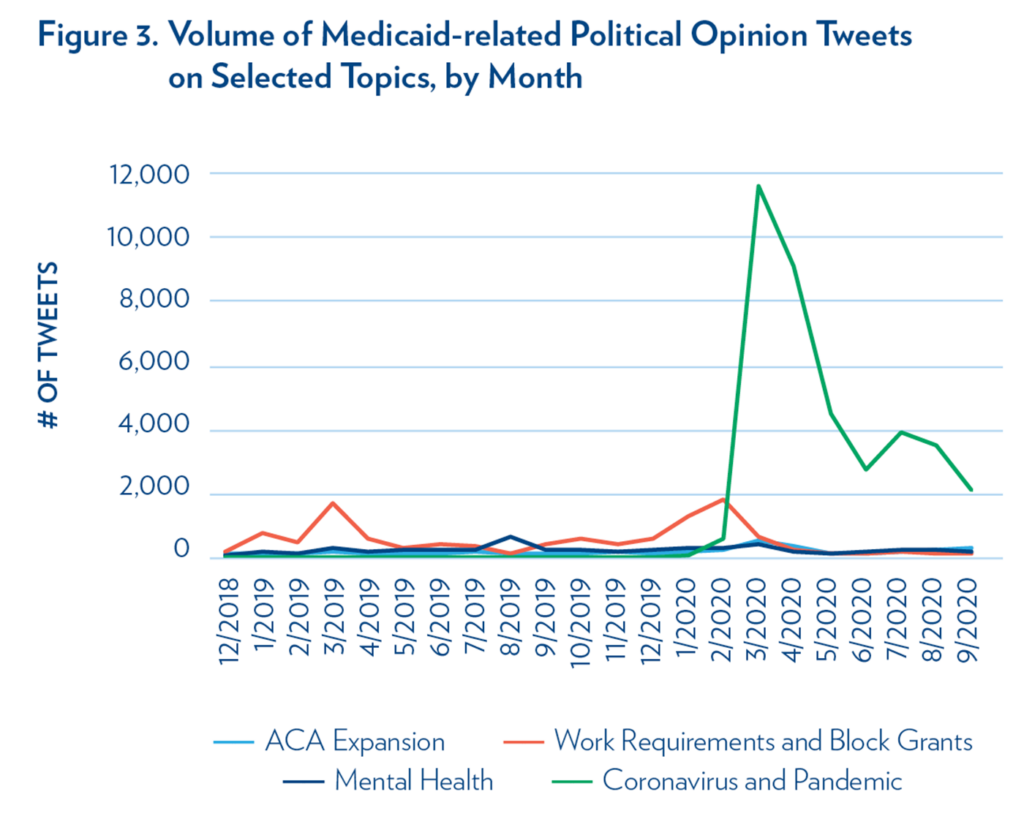
In analyzing the sentiments expressed in the tweets, we find that Medicaid expansion is among topics that are more likely to be discussed in a positive light, with nearly 50% of tweets expressing positive sentiment and about 20% of tweets expressing negative sentiment (Figure 4). In comparison, the topic of work requirements appears to be more polarizing, with similar proportions of tweets reflecting positive and negative sentiments in public posts. After the start of the COVID-19 pandemic in the first quarter of 2020, there appeared to be a growing share of neutral valence tweets and a slight decrease in negative sentiments about Medicaid topics, suggesting that polarized viewpoints about Medicaid may have been lessened in the context of the pandemic.
In this exploratory analysis, we found a high volume of political posts on Twitter around Medicaid topics, peaking in January 2020 in the context of news about Medicaid expansion and the prior administration’s unveiling of a Medicaid block grant plan. As the COVID-19 pandemic hit the U.S., Twitter posts increased in volume about Medicaid and the pandemic, and the volume of political tweets on other Medicaid-related topics dropped. The posts themselves also appeared to be less polarized, with more posts of a neutral valence and fewer with strongly positive or negative sentiments.
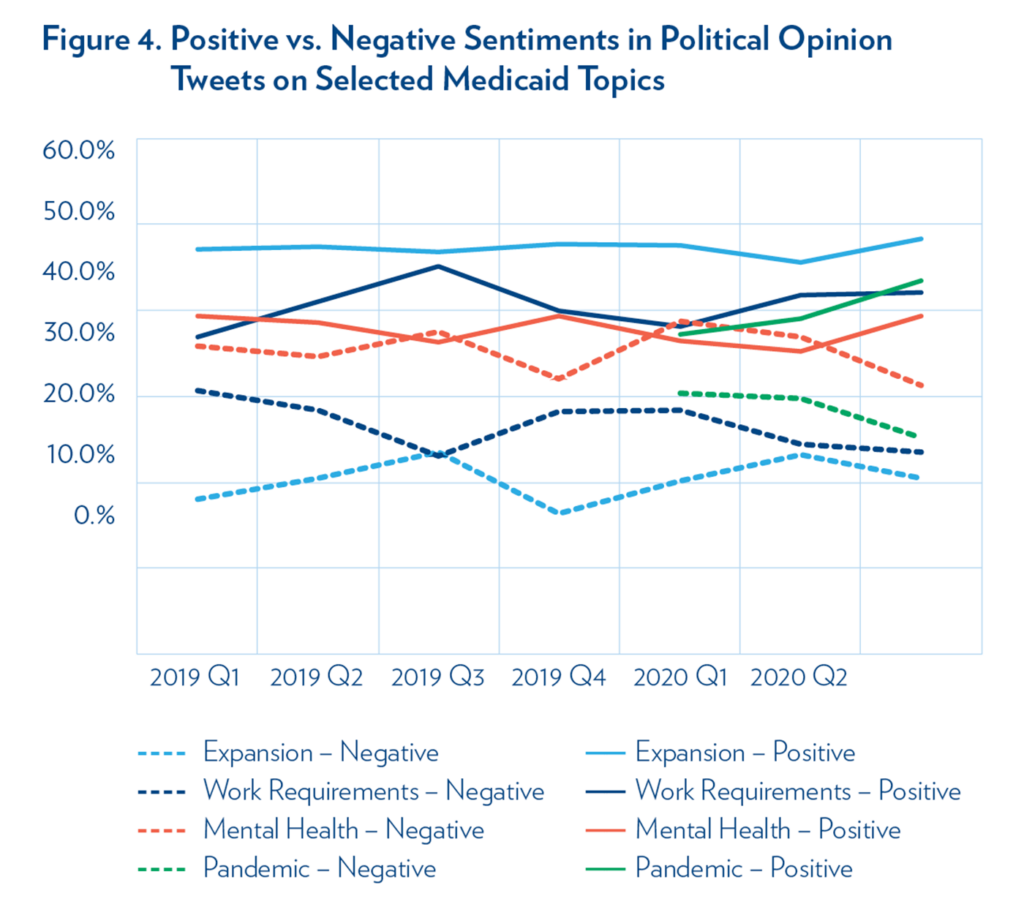
These patterns suggest that when the public sees Medicaid operate in its core function as a safety net, the program is far less polarizing than partisan politics might indicate. Highlighting Medicaid’s role during the pandemic could help strengthen public support for the program in non-crisis times and better position it to respond to future economic downturns.
There are a number of limitations in this exploratory study, including the possibility that Twitter posts could be miscategorized using a machine learning algorithm. Moreover, sentiment analysis may not capture the specific context of particular posts, including irony, sarcasm, and hyperbole.
However, our analysis shows that Twitter — and social media more generally — is a potential source of data to supplement or complement public polling data and anecdotal evidence on the public’s views towards a heavily politicized program like Medicaid. Public perception of the program is important and evolving. Public views can have a strong effect in driving or supporting programmatic changes, as demonstrated by an increase in voter-approved ballot initiatives for Medicaid expansion in multiple states. One study found that Americans connected to the program were more likely to view Medicaid as important and to support increases in spending (even controlling for partisanship).8 Social media has been used to mine opinions for commercial and market purposes; to amplify and disseminate public health messaging; and to conduct public health surveillance and research. Social media environments, where people are able to make connections and publicly express their views, could also be used to help destigmatize Medicaid, increase awareness, and facilitate direct advocacy for programmatic and policy change.
Because Medicaid is a state-based program, further research is needed to understand the relationship between public opinion, as expressed on social media, and its impact on Medicaid stakeholders, political leaders, and specific program or policy changes. A promising approach would be to identify geographic locations of Twitter users and link public opinion and framing with state-specific policy discussions. This more granular exploration would provide greater insight into the nature of positive and negative sentiments around issues like work requirements and how public views vary by state or in response to state-based policy changes.
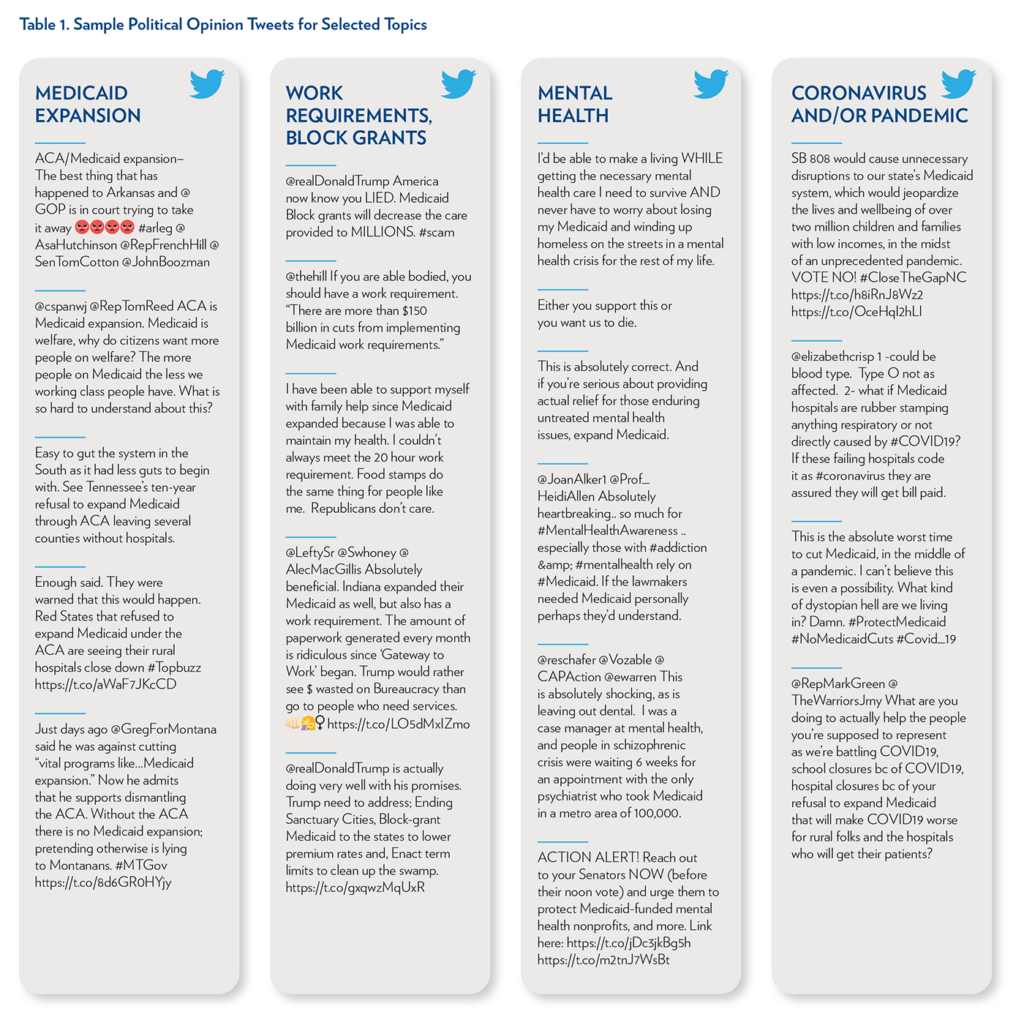

Stable Payments Improved Margins But Not Liquidity, New LDI Analysis Finds

LDI Senior Fellow Cited for “Significant Contributions” in Research

Outdated Laws Target Black and Queer Lives in Over 30 States, Fueling a Deadly Disease

Selected for Current and Future Research in the Science of Amputee Care

Research Memo: Delivered to House Speaker Mike Johnson and Majority Leader John Thune

Research Memo: Delivered to House Speaker Mike Johnson and Majority Leader John Thune